-

新人教版高中英语选修2Unit 3 Learning about Language教学设计
1. We'll need ten months at least to have the restaurant decorated.2.Some traditional Chinese dishes from before the Ming Dynasty are still popular today.3.My grandpa's breakfast mainly includes whole grain biscuits and a glass of milk.4.People in this area would eat nearly a kilo of cheese per week.5. We enjoyed a special dinner in a fancy restaurant where the waiters all wore attractive suits.6. He prefers this brand of coffee which, as he said, has an unusually good flavor.Key:1. at a minimum 2. prior to3. consist of4. consume5. elegant6. exceptionalStep 5:Familiarize yourself with some food idioms by matching the meaning on the right with the colored words on the left.1.Public concern for the health of farm animals has mushroomed in the UK2.Anderson may be young but he's certainly rolling to doing dough!3.George is a popular lecturer. He often peppers his speech with jokes.4.As the person to bring home the bacon, he needs to find a stable job.5 He is often regarded as a ham actor for his over emphasized facial expressions. The media reported that these companies had treated pollution as a hot potato. 6.The media reported that these companies had treated pollution as a hot potato.7.Don't worry about the test tomorrow. It's going to be a piece of cake!8. It's best to fold the swimming ring when it is as flat as a pancake.A. completely flatB. something that is very easy to do C.an issue that is hard to deal withD.to include large numbers of somethingE.to earn on e's living to support a familyF. wealthyG.to rapidly increase in numberH. an actor who performs badly, especially by over emphasizing emotions

新人教版高中英语选修2Unit 2 Learning about Language教学设计
The activity theme of this section is to design various activities around the key words in the first text. Therefore, the activities require students to pay attention to the spelling of words. On the other hand, let students grasp the meaning of words more accurately through sentences and short texts. This kind of teaching design also helps to improve the ability of using English thinking.1. Cultivating students' ability to use word formation to induce and memorize vocabulary, and the ability to use lexical chunks to express meaning.2. Guide the students to think independently and use the correct form of words to complete sentences3. Cultivate students' habit of using lexical chunks to express language completely, guide students to draw words in sentences quickly, pay attention to word collocation, so as to accumulate more authentic expressions4. Instruct students to create sentences with the chunks.1. Enable students to use the language points in the real situation or specific contexts flexibly and appropriately.2. Guiding the Ss to use unit topic words and the sentence patterns in a richer context.Step1: Think of a word that best fits each definition.1. to remember sth2.to accept, admit, or recognize sth or the truth/existence of sth3. the process of changing sth or yourself to suit a new situation4 .to make sb feel less worried or unhappy5. a strong desire to achieve sth

新人教版高中英语选修2Unit 5 Reading for writing教学设计
你校英语报计划出版一期急救常识专刊,现面向全校学生公开征集稿件,你有意参加。请你根据下面提示内容,用英语写一篇短文,介绍在车祸现场对伤者进行急救的方法和步骤。1.确保现场的安全;2.询问伤者,确保其呼吸正常;3.检查伤口,如流血则应采取止血措施;4.如需急救,确保其处于康复位置。注意:1.词数80左右;2.可以适当增加细节,以使行文连贯。参考词汇:康复位置 recovery positionAs we all know, having a knowledge of first aid can make a great difference in our daily life. If a traffic accident happens and someone is injured, the following steps can be used to treat the injured.In the first place, we should make sure that the accident scene is safe so that we won’t get hurt. We should ask the injured person if he is OK, and see if he is breathing. What’s more, we should check for cuts and wounds. If he is bleeding badly, it is vital that we should try to stop the bleeding by applying pressure to the injury. This is because if a person loses too much blood, he may die. If necessary, take the injured person to the hospital as soon as possible.Do remember: when giving first aid, please be sure to place the person in a recovery position.

新人教版高中英语选修2Unit 4 Learning about Language教学设计
This section guides students to pay attention to the typical context of vocabulary use, helps students accumulate vocabulary around the key vocabulary of this unit, and uses the learned words and word chunks in different contexts to deeply understand their meaning and usage, so as to achieve the purpose of review and consolidation.The teaching design activities aim to guide students to pay attention to the typical context in which the target vocabulary is used, as well as the common vocabulary used in collocation, so that students can complete the sentence with correct words. In terms of vocabulary learning strategies, this unit focuses on cultivating students' ability to pay attention to collocation of words and to use word blocks to express meaning.For vocabulary learning, it is not enough just to know the meaning of a single word, but the most important thing is to master the common collocations of words, namely word blocks.Teachers should timely guide students to summarize common vocabulary collocation, such as verb and noun collocation, verb and preposition collocation, preposition and noun collocation, and so on.1. Guide students to understand and consolidate the meaning and usage of the vocabulary in the context, 2. Guide the students to use the unit topic vocabulary in a richer context3. Let the students sort out and accumulate the accumulated vocabulary, establishes the semantic connection between the vocabulary,4. Enable students to understand and master the vocabulary more effectivelyGuiding the Ss to use unit topic words and the sentence patterns in a richer context.

新人教版高中英语选修2Unit 4 Using langauge-Listening教学设计
The theme of the listening section is " talking about scenery and culture along a journey."The part is designed to further lead the students to understand Canadian natural geography and social environment, and integrated into the cultural contrast by mentioning the long train journey from Beijing to Moscow routes. On this basis, the part activates students related travel experience, lets the student serial dialogue, guides the student to explore further the pleasure and meaning of the long journey, and Chinese and foreign cultural comparison.The part also provides a framework for the continuation of the dialogue, which is designed to provide a framework for students to successfully complete their oral expressions, and to incorporate an important trading strategy to end the dialogue naturally.1. Help students to understand and master some common English idioms in the context, and experience the expression effect of English idioms.2. Guide the students to understand the identity of different people in the listening context, and finish the dialogue according to their own experience.3. Instruct the students to use appropriate language to express surprise and curiosity about space and place in the dialogue, and master the oral strategy of ending the dialogue naturally.1. Instruct students to grasp the key information and important details of the dialogue.2. Instruct students to conduct a similar talk on the relevant topic.

新人教版高中英语选修2Unit 5 Learning about Language教学设计
The purpose of this section of vocabulary exercises is to consolidate the key words in the first part of the reading text, let the students write the words according to the English definition, and focus on the detection of the meaning and spelling of the new words. The teaching design includes use English definition to explain words, which is conducive to improving students' interest in vocabulary learning, cultivating their sense of English language and thinking in English, and making students willing to use this method to better grasp the meaning of words, expand their vocabulary, and improve their ability of vocabulary application. Besides, the design offers more context including sentences and short passage for students to practice words flexibly.1. Guide students to understand and consolidate the meaning and usage of the vocabulary in the context, 2. Guide the students to use the unit topic vocabulary in a richer context3. Let the students sort out and accumulate the accumulated vocabulary, establishes the semantic connection between the vocabulary,4. Enable students to understand and master the vocabulary more effectivelyGuiding the Ss to use unit topic words and the sentence patterns in a richer context.Step1: Read the passage about chemical burns and fill in the blanks with the correct forms of the words in the box.

新人教版高中英语选修2Unit 5 Reading and thinking教学设计
The theme of this activity is to learn the first aid knowledge of burns. Burns is common in life, but there are some misunderstandings in manual treatment. This activity provides students with correct first aid methods, so as not to take them for granted in an emergency. This section guides students to analyze the causes of scald and help students avoid such things. From the perspective of text structure and collaborative features, the text is expository. Expository, with explanation as the main way of expression, transmits knowledge and information to readers by analyzing concepts and elaborating examples. This text arranges the information in logical order, clearly presents three parts of the content through the subtitle, accurately describes the causes, types, characteristics and first aid measures of burns, and some paragraphs use topic sentences to summarize the main idea, and the level is very clear.1. Guide students to understand the causes, types, characteristics and first aid methods of burns, through reading2. Enhance students’ ability to deal withburnss and their awareness of burns prevention3. Enable students to improve the ability to judge the types of texts accurately and to master the characteristics and writing techniques of expository texts.Guide students to understand the causes, types, characteristics and first aid methods of burns, through readingStep1: Lead in by discussing the related topic:1. What first-aid techniques do you know of ?CPR; mouth to mouth artificial respiration; the Heimlich Manoeuvre

新人教版高中英语选修2Unit 5 Using langauge-Listening教学设计
The theme of this section is to learn how to make emergency calls. Students should learn how to make emergency calls not only in China, but also in foreign countries in English, so that they can be prepared for future situations outside the home.The emergency telephone number is a vital hotline, which should be the most clear, rapid and effective communication with the acute operator.This section helps students to understand the emergency calls in some countries and the precautions for making emergency calls. Through the study of this section, students can accumulate common expressions and sentence patterns in this context. 1.Help students accumulate emergency telephone numbers in different countries and learn more about first aid2.Guide the students to understand the contents and instructions of the telephone, grasp the characteristics of the emergency telephone and the requirements of the emergency telephone.3.Guide students to understand the first aid instructions of the operators.4.Enable Ss to make simulated emergency calls with their partners in the language they have learned1. Instruct students to grasp the key information and important details of the dialogue.2. Instruct students to conduct a similar talk on the relevant topic.Step1:Look and discuss:Match the pictures below to the medical emergencies, and then discuss the questions in groups.
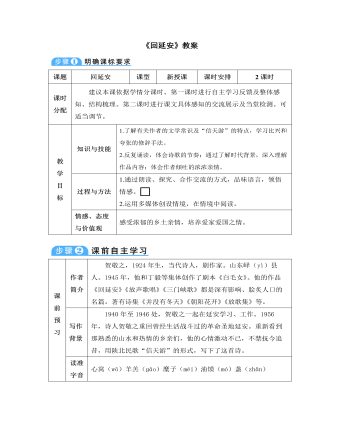
部编版语文八年级下册《回延安》教案
【初读课文,整体感知】1.诗歌共分为五小节,这五小节分别写了什么内容?第一小节:阔别十年重回延安;第二小节:追忆当年战斗生活;第三小节:亲人相见话延安;第四小节:喜看延安今繁华;第五小节:颂延安光辉历史。2.试想想诗人写作这首诗抒发思想情感的线索是什么?讨论、明确:全诗以诗人离别10年后重返延安的所见所闻所想为线索。【细读课文,仔细品味】1.作者在第一节中是怎样通过一系列动词表现情感的?“抓”“贴”等逼真的动作,表现了诗人回到延安时的激动情景。“双手搂定宝塔山”的“搂”字,写尽了作者对延安的怀念。“唱”“笑”“招”具有拟人的色彩,渲染了欢乐的气氛。最后一个“扑”字,强烈、准确地表达出作者的想念。2.第二节中,“二十里铺送过柳林铺迎,分别十年又回家中”在结构上有什么作用?
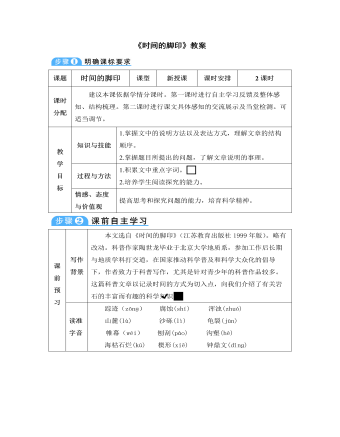
部编版语文八年级下册《时间的脚印》教案
【初读课文,整体感知】1. 以《时间的脚印》为题目有什么好处?文章的题目《时间的脚印》,是从高士其《时间伯伯》一诗中引申借用来的。其拟人化手法的运用,形象地说明了那些形形色色、大大小小的岩石中都潜藏着时间的踪影,以引起人们的探究欲望和阅读兴趣。【再读课文,梳理结构】1.第一部分(第1至第4自然段)说明岩石“是记录时间的方式中最重要的一种”。2.第二部分(第5至第29自然段)分层次地详细说明岩石是怎样记录时间的。这部分分三层。3.第三部分(第30自然段至全文完)总结全文,说明岩石记录时间的意义,号召人们进一步去大自然找寻时间的踪影,去一步步走向地下的宝库。【感悟精彩句子】1.“狂风来了,洪水来了,冰河爬来了”。
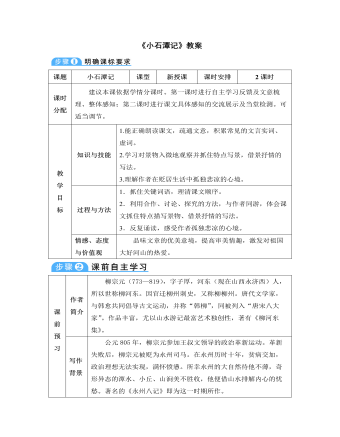
部编版语文八年级下册《小石潭记》教案
【品读课文,把握情感】1.小石潭到底有哪些乐趣呢?(找出“乐”的句子)(1)闻水声,如鸣珮环,心乐之。(2)似与游者相乐。2.深入探究,走近柳宗元。 “一切景语皆情语”,面对如此优美的景色,作者的心情却是“悄怆幽邃”。(播放一首古筝乐曲)这首古筝曲能为课文朗诵配乐吗?你能结合写作背景,说说你的理解吗?作者是被贬官到永州,不幸的遭遇令他感伤,本来想寄情于山水,遣散心中的郁闷,小石潭的美景使他惊叹不已,流连其中,得到了不少乐趣,暂时忘记了心中的痛苦,可是小石潭风景虽美却过于幽静冷清,游玩的时间一长,寒气透骨,难免触景生情,不由得忆起了自己的坎坷命运,忧郁、悲凉的心情自然地流露出来。3.柳宗元怀才不遇的悲凉郁闷,透过文字显现出来了。那么还有哪些中国文人用文字来书写心中壮志难酬的情感?
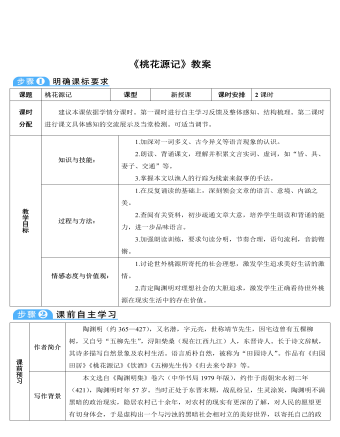
部编版语文八年级下册《桃花源记》教案
首先,我让学生结合书下注释,自行朗读课文。在读准字音的基础上,由老师带感情朗读,配合优美的乐曲,一下子便把学生带到课文的意境中,然后再由学生仿读,边读边体会,读中导,读中悟。接着,给学生自主学习的空间。我要求同学们凭借下面的注释,结合语境翻译课文,然后小组自主探究,最后小组提出疑难点,教师在班上引导学生解决,并把文言实词虚词归类。三、反复诵读,品味佳句,突破重难点。如果说前面的读是在为品做准备,那么真正的品就在学生对文章优美佳句的欣赏上,要求学生仔细品味自认为文中写得好的语句。这一环节我首先让学生自行找出自己喜爱的地方,然后说明喜爱的原因。这既是一种对课文的理解,又是一种知识的迁移。

部编版语文九年级下册《变色龙》教案
小结:总之,手指头的细节描写写出了赫留金的命运和遭遇,它从反面衬托出奥楚蔑洛夫见风使舵、媚上欺下的卑劣品质,反映了沙皇统治下社会的黑暗。目标导学五:分析讽刺艺术,把握文章主旨1.作为一篇讽刺小说,本文主要运用了哪些手法表现讽刺艺术?明确:夸张。讽刺小说往往离不开夸张,本文也是如此。在短短的时间里,随着狗的主人的身份不断变化,奥楚蔑洛夫的态度也发生了多次变化。变化之快,跨度之大,令人瞠目。夸张手法的巧妙运用,使人物性格鲜明突出,给人留下了深刻的印象。对比。奥楚蔑洛夫面对狗主人身份的变化,不停地改变着自己的态度,时而威风凛凛,时而奴颜婢膝,一会儿痛骂小狗是“疯狗”“下贱胚子”,一会儿又夸小狗“名贵”“伶俐”,前后矛盾,对比鲜明,自己打自己的嘴巴,使小说的喜剧效果更加突出。
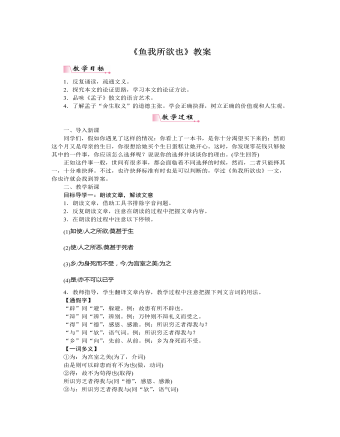
部编版语文九年级下册《鱼我所欲也》教案
明确:提出“生与义不可得兼,舍生而取义者也”的论点后,首先从正面指出人之所以能“舍生取义”,是因为人皆有“欲生不为苟得,恶死有所不辟”的思想。然后再从反面说明,如果人只是欲生恶死,那么什么事都可以做得出来;可是事实上,“义”超过了“生”,所以人能够不贪生,不避死。这种羞恶之心,人人皆有,贤者更能保持而不丧失。接着举例说明,以乞人不受不义之食为例,从正面论证“舍生取义”是人之共性。以万钟虽好也不能受为例,从反面强调了舍义取利是丧失本心。随后用一组排比句,对不辩礼义而贪求富贵的行为加以批判,并以“此之谓失其本心”收束全文,照应开头。3.列举本文主要的论证方法,并说明其作用。明确:(1)比喻论证。用比喻论证引出论点。以生活常理为喻引出生与义无法兼顾的情况下应该舍生而取义的结论(主旨)。
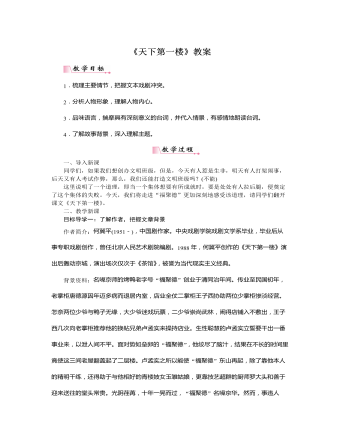
部编版语文九年级下册《天下第一楼》教案
明确:修鼎新的一句话“一个人干,八个人拆”是对上述情节最好的概括。从全文来看,唐茂昌与唐茂盛是只知出不知入的二世祖,成心要钱挥霍,且二少爷直接挖走店里的得力助手,这比坐吃山空的后果更加严重;罗大头是烤鸭一把手,克五又知道他藏着烟土,这无疑是罗大头将要出事的信号。且罗大头自恃烤鸭技艺离去,这对于“福聚德”无疑是有打击力的;此外,连小伙计都不成器。种种迹象,几乎都指向“福聚德”即将衰落。究其根本原因,可以说,这是勤劳务实的人与东家少爷、克五这样混吃混喝的人的矛盾,是平民与欺压平民的官僚之间的矛盾。这矛盾,才是“福聚德”真正衰落的原因。目标导学三:把握文本语言特征,理解含义深刻语句1.本文语言十分具有方言特色,甚至有些方言运用比较低俗,你如何看待这个问题?请结合文章做简要分析。
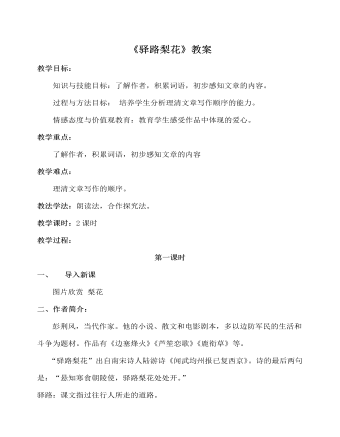
部编版语文七年级下册《驿路梨花》教案
教学目标:知识与技能目标:了解作者,积累词语,初步感知文章的内容。 过程与方法目标: 培养学生分析理清文章写作顺序的能力。 情感态度与价值观教育:教育学生感受作品中体现的爱心。教学重点:了解作者,积累词语,初步感知文章的内容教学难点:理清文章写作的顺序。教法学法:朗读法,合作探究法。教学课时:2课时教学过程:
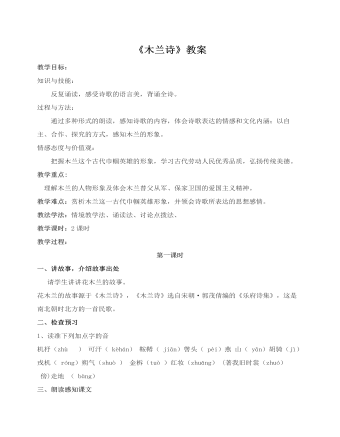
部编版语文七年级下册《木兰诗》教案
七、分析木兰形象既有女儿情怀 更具英雄气概古代杰出的巾帼英雄形象奇女子 普通人既是 巾帼英雄 又是 平民少女矫健的勇士 娇美的女儿品质勤劳善良又坚毅勇敢 淳厚朴实又机敏活泼 热爱亲人又报效国家 不慕高官厚禄而热爱和平生活八、探究写法诗中哪些地方写得详细?哪些地言写得简略?这样写有什么好处?从军缘由——详写出征前的准备——略写出征中的思亲心理——详写关山飞度,征战沙场——略写 详写女儿情态略写英雄气概凯旋辞官——详写家人迎接——详写木兰改装——详写1(在内容上)突出木兰的儿女情态,丰富了木兰的英雄性格,使得人物形象真实感人。2(在结构上)详略得当,使全诗显得简洁紧凑。繁简安排有详有略起到了突出人物特征 突出对木兰的孝敬父母、勇于担当重任的性格的颂扬
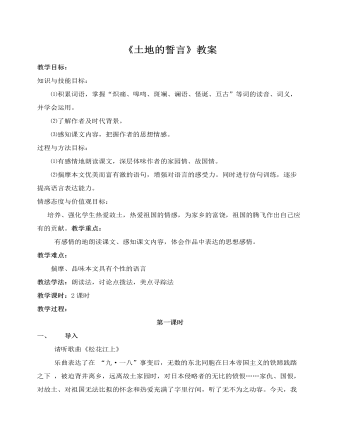
部编版语文七年级下册《土地的誓言》教案
抒情句子1、对于广大的关东原野,我心里怀着炽痛的热爱。我无时无刻不听见……因为我常常感到它在泛滥着一种热情。 2、我总是被这种声音所缠绕,……我都会突然想到是我应该回去的时候了。3、在故乡的土地上,我印下我无数的脚印。在那田垄里埋葬过我的欢笑。 ……在那沉重的镐头上留着我的手印。2、怎样理解文中的“我常常感到它在泛滥着一种热情”中的“泛滥”与“在那田垄里埋葬过我的欢笑”中的“埋葬”这两个词语的确切含义?“泛滥”原意是“江河水溢出,淹没土地”,又引申为“思想、事物到处扩散”。这里用 “泛滥”表达了作者的心情正如决堤之水不可遏抑地向四下泛滥奔流,作者那激愤狂放的心情用了“泛滥”来形容较之用“澎湃”“涌动”更多了几分野性和难以驾驭的力量。`
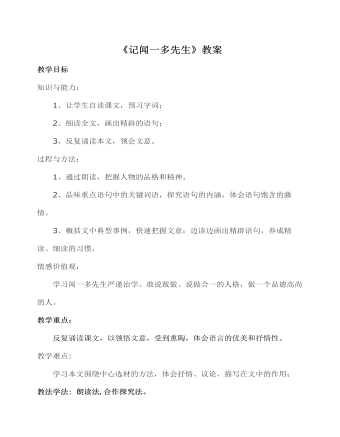
部编版语文七年级下册《记闻一多先生》教案
3、文章怎样写“作为争取民主的战士”的闻一多先生的“说”与“做”的? 文章先写他的“说”,写他“说”的事实,由“小声说”到“向全国人民呼喊”,写他“说”的内容与目的反对独裁,争取民主。再叙他的“做”:起稿政治传单,在群众大会上大骂特务,走在游行示威队伍的前头,昂首挺胸,长须飘飘。用他的“说”和“做”揭示其争取民主、反对独裁的大无畏精神。 4、细读全文,画出精辟的语句,然后复述课文大意,并说出闻一多前期和后期思想品格上的主要特点,前后期有什么变化,又有什么共同的地方。闻先生前期为了探索其救国救民的出路而潜心学术,不畏艰辛,废寝忘食,十数年如一日,终于在学术上取得累累硕果。后期则投身于民主运动,敢于为人民讲话,面对凶残的敌人无所畏惧,视死如归,体现出民主战士的大勇,成为中国革命知识分子的楷模。闻先生在前期和后期所走的道路不同,反映了他对社会认识的变化。但作为一名卓越的学者,一名伟大的爱国者,一名言行一致的志士仁人,他却是始终如一的。
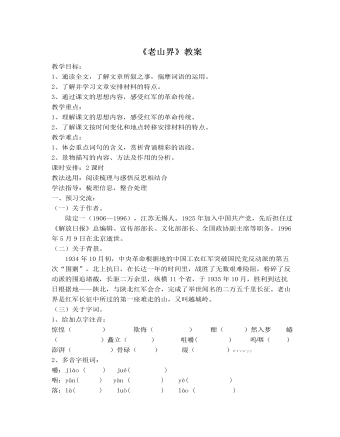
部编版语文七年级下册《老山界 》教案
用巨人矗立比喻眼前的山峰;用一口井比喻山谷,既突出了山势的险峻和连绵,又暗示了红军的艰难处境。“矗立”,形象的说明困难像拦路虎阻挡在面前,但是直立、高耸的老山界阻挡不了红军北上抗日的决心,也改变不了他们的长征必胜的信念。“极远的又是极近的,极洪大的又是极细切的,像春蚕在咀嚼桑叶,像野马在平原上奔驰,像山泉在呜咽,像波涛在澎湃。” 用了什么修辞手法?写出了作者怎样的感受?“像春蚕在咀嚼桑叶”时连续不断的细微声音,比喻战士们轻细的话语声,说明战士们被冻醒次数之多;“野马奔驰”写半夜山风之大,又喻寒风刺骨;“山泉呜咽”用拟人化手法喻山泉时断时续又暗指山势崎岖;“波涛澎湃”形容林木被风刮动的声音。人声和大自然的声音交织在一起,烘托出夜色之深,夜景之美,透露出勃勃生机,洋溢着革命乐观主义精神。非常形象地写出山景之美,表现红军战士的乐观情怀。

